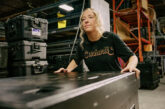
Peter Dumigan of Snickers Workwear looks at how to utilise protective clothing to ensure your safety when working in hazardous environments.
In order for an individual piece of protective wear clothing to be awarded a Category III CE Certification, it has to undergo independent testing by a specialist test laboratory. Certification results from the independent testing and subsequent validation that a product undergoes in order to comply with an approved set of performance standards.
In the case of high-risk environments where the danger of an electric arc hazard is present, the certification process examines whether or not the item – in this case protective clothing – complies with a range of regulatory requirements.
Physical testing of protective wear for electric arc hazards
These physical tests employ two different test methodologies, Open Arc Tests and Box Tests. Both methodologies use different test-set-ups, arc configurations and types, test parameters, test procedures and result parameters.
Both tests examine the suitability and performance of the garment fabrics against the thermal hazards of an electric arc. Specifically, the tests are designed to ensure that the garments retain their integrity and are not damaged in such a way that the person wearing the garments is injured.
When an electric arc is triggered, different types of energy and risk factors are created, such as arc power, arc energy and incident energy, all of which are measured in calories. This is why calorie per square centimetre (cal/cm²) has become the unit of measurement used to establish the level of protection of a fabric or garment.
The test methodologies used by the test labs have to replicate real-life hazards and the various consequences of electric fault arcs. This includes thermal effects, electric shocks, noise, UV emissions, pressure, shrapnel, as well as the flame-retardant capacity of the clothing.
Design requirements of protective wear
The IEC 61482-2 certification specifies requirements for clothing designed to protect against the thermal hazards of an electric arc. These garments belong to the Risk III category, which are certified to eliminate second-degree burns in the event of an electric arc flash (flashover). Second-degree burns are potentially extremely painful and are usually characterised by skin blisters and vigorous swelling. There is also the risk of local infection and scarring.
Although still serious, second-degree burns are not the worst you could suffer from a burn, with third- and fourth-degree burns proving far more damaging. It is absolutely essential that professional electricians and anyone dealing with electricity properly protects themselves from these nasty injuries which have the potential to be life-threatening.
The garments belonging to this Risk III category include underwear, socks, gloves, underpants and t-shirts or shirts worn as a mid-layer. It’s important to remember that the more layers of electric-arc-protective clothing you wear, the higher your protection. As such, Snickers Workwear recommends dressing with appropriate base-, mid- and top-layer garments.
The design requirements also dictate that clothing shall protect the whole body and that
there should be no metal parts on either the external surface or the inside of the garment. Further still, a garment’s main seams should be sewn with flame retardant thread, tested to withstand temperatures up to 260˚C.
Additionally, the outermost garment has to be flame resistant. It’s worth remembering that non-flame-resistant garments (i.e. rainwear, jackets, cold weather garments, etc.) can ignite in an electrical arc and continue to burn, negating the protective capacity of any protective clothing worn underneath.
Wear layers to increase your protection
The best way to improve your level of protection is to wear accredited base-, mid- and top-layer clothing. A fundamental requirement is of course that all the garments are certified and flame retardant.
The main and very important benefit of wearing layers is that the air gap formed between different garments provides an extra layer of increased protection. Although there is no general rating for the level of increased protection provided by the air gap between layers, Snickers Workwear has conducted a number of tests which produce some important results. The tests reveal that the air gap between layers increases protection by more than 5 cal/cm².
What we know for certain is that wearing multiple layers improves the protection rating. It’s therefore best to think of the air gap between each layer as extra protection that improves your chances of avoiding burns in the event of an accident.
Understand the risks – choose the right level of effective protection
Working in high-risk environments involves, as the name implies, high-risk levels which are not to be underestimated. Arcs due to electrical faults can cause severe injuries and damage, so it’s vital that you choose the right protective wear to ensure your safety and well-being on site.
Snickers Workwear ProtecWork range
This fully accredited and independently tested protective wear for heat and flame, electrostatic and chemical risk environments delivers -leading risk-protection in a wide range of hazardous working environments. The key features and benefits of the clothing includes the hi-tech, advanced fabric technology integral to the Base-, Mid- and Top-Layer garments for both men and women that combine well with the Snickers Workwear hallmarks of durability, comfort, ergonomics and fit.
What to do in the event of a burn
In the event of a burn to either yourself or someone else, it is essential that you seek medical advice immediately. In the meantime, however, you should seek to stop the burning happening straight away, if it continues, by removing the person from the area. Secondly, remove any clothing or jewelry but not if it is stuck to the skin. Removing clothing stuck to the skin can potentially cause more damage. You should also seek to cool the burn with cool or lukewarm water, but never use ointments or ice and ice water. But, of course, the best way to deal with burns is prevent them happening in the first place! So, be safe out there.
For more information on the range, please visit: https://www.snickersworkwear.com/products/80










